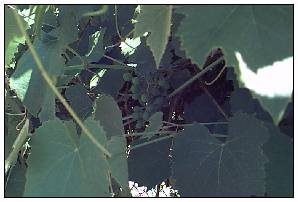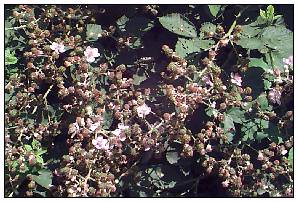 Station 5: A Great Draped Grape
Station 5: A Great Draped Grape
THE WOODY VINE draped on the trees along the bank is western wild grape (Vitis californica). It can grow up to 50 feet tall, entwining its host tree and eventually causing its death. The wild grape has poisonous roots, but its fruit is edible and can be made into jelly or wine. The fall foliage is a beautiful yellow orange. The tall trees the grape is covering are black cottonwoods, the tallest native cottonwood in the United States. Black cottonwood is an extremely fast-growing tree that is found where its roots can locate water all year. Its winged seeds are short-lived unless they find moist soil in which to sprout. Its sticky, aromatic buds are especially pungent in the spring, giving the riparian area its characteristic fragrance. It has edible fruits called catkins, and the wood has been used for smoking fish. In winter, look for its heart-shaped leaves on the ground.
The most common plant along the path is the blackberry. Imported from Eurasia, the Himalayan berry (Rubus procerus) is a formidable weed. Armed with long, hooked barbs, it clambers over other plants and smothers them. The blackberry has both a deep, tough root system and efficient seed dispersal. Birds prize the berries, and spread them far and wide. The brambles also provide good cover for the birds. The ability to root when the tips of the canes bend down and contact the soil ensures its spread over wide areas. Berry pickers everywhere love this plant, but it can be a serious deterrent to forest regeneration because of its invasive habit.

Photo by D.L. Mark.


















